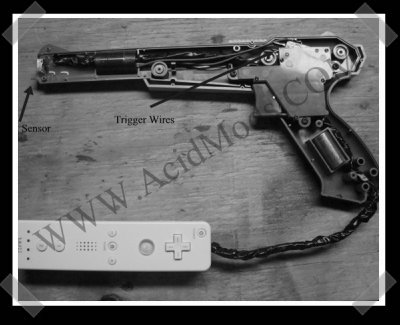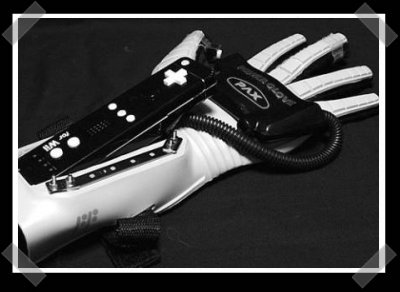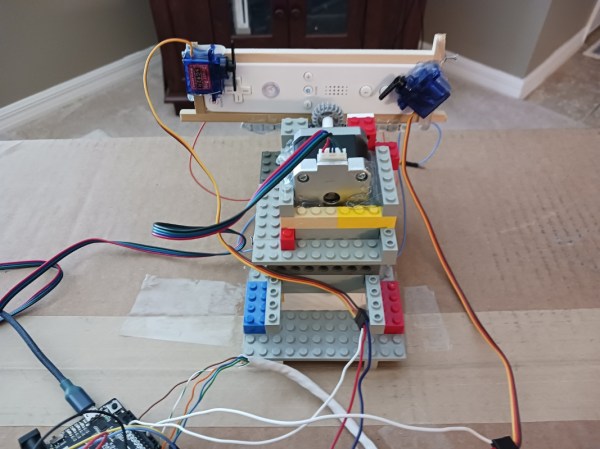
[F00 f00] sent in his friends lightgun wiimote mod. The IR sensor is carefully de-soldered and relocated to the barrel and the trigger is wired into the fire button. There’s a video of game play, but you can hit it over at acidmods.
Powerglove Wiimote

How, oh how did I miss this one? (original) A japanese hacker merged a powerglove with a wiimote. Need I say more? Seriously, who didn’t want a powerglove when they came out? video of the thing in action is after the break.
Quick extra:
It turns out that the Wii Nunchuck is a great source for parts. It’s got a 3-axis accelerometer, joystick and buttons for a mere $20 [chad]’s wrote a full how-to on turning a wii controller into a bluetooth transmitter and an interface for the wii nunchuck for the Arduino.
.
Wiimote Windows Drivers!
Just a quick update to yesterday’s Wiimote bluetooth hack. [steve] pointed out [CarlKenner]’s release of a windows driver. Let us know how this works. Looks like you have to use the slightly deprecated/abandoned PPjoy to get the joystick functions working.
So, if you have a HTPC, maybe the Wiimote could make an interesting home theater remote? (I use linux on mine these days. The windows display drivers kept breaking)
Hacking Wiimote Bluetooth
[mo] sent me this video showing the latest on hacking the wiimote via bluetooth . They haven’t figured out all the values yet, but this is only the beginning. How long until we see some mac/pc games that can use the Wiimote?
Building A Keychain Wii Looks Possible
The original Nintendo Wii was not a big console, per se, but you could never hope to fit one in your pocket. Or…could you? As it turns out, console modders [Wesk] and [Yveltal] reckon they have found a way to make a functional Wii at the keychain scale!
The concept is called the Kawaii, and as you might expect, some sacrifices are necessary to get it down to pocketable size of 60 x 60 x 16 mm. It’s all based around the “Omega Trim,” an established technique in the modding community to cut a standard Wii motherboard down to size. Controllers are hooked up via a dock connection that also provides video out. There’s no Bluetooth, so Wiimote use is out of the question. You can still play some Wii games with GameCube Controllers by using GC2Wiimote, though. The Wii hardware is under-volted to allow for passive cooling, too, with an aluminum enclosure used to shed heat. Custom PCBs are used to handle power and breakouts, which will be open sourced in due time.
The forum post featured an expression of interest for those eager to order aluminium enclosures to pursue their own Kawaii build. Slots quickly filled up and the EOI was soon closed.
As of now, the Kawaii is still mostly conceptual, with images being very compelling renders. However, it relies on established Wii modding techniques, so there shouldn’t be any shocking surprises in the next stage of development. Expect to see finished Kawaii builds in gorgeous machined aluminum housings before long.
We’ve seen some other great Wii portables over the years. The console remains cheap on the used market and was built in great numbers. Thus, it remains the perfect platform for those eager to get their feet wet in the console modding community!
Swapping Nunchucks For A Steering Wheel
Rather than chasing pure performance and high quality graphics like other gaming companies, Nintendo has made a name for themselves over the last few decades by favoring not only artistic design and gameplay, but the physical design of the game systems. Of course the hybrid handheld Switch console is among these, but it also includes things like the novel design of the Nintendo 64 controller and, of course, the Wii nunchuck controllers. They’re not always met with resounding approval, though. Some of us tend to prefer more traditional gamepad design, and will go to extreme lengths to get it like this D-pad for playing Mario Kart Wii.
Rather than simply building a compatible controller for the Wii, or even using a GameCube controller, this controller setup takes a more roundabout approach. A Wiimote is placed in a holster built from Lego, and the game is set up to recognize it as if it were being used in its steering wheel mode. The Lego holster has a servo attached which can tilt the Wiimote from side to side, mimicking a player holding it to play the game, with another set of servos set up to press the various buttons. To control the controller, a homebrew D-pad built on perfboard with an Arduino at its core is used to send commands to the servos, allowing for a more standard controller layout to be used for the classic kart racing game than the steering wheel Wiimote allows.
While it’s quite obvious that there are simpler, easier solutions that avoid the sometimes awkward nature of using Wiimotes, we certainly appreciate the Rube Goldberg-like approach to setting up your gaming experience exactly the way you like. Whether that’s setting up an antique CRT effect for the authentic retro gaming experience or building a complete racing simulator from scratch, the gaming experience is ripe for personalization and unique builds like this one.
Wii-Inspired Controller Built Using Raspberry Pi Pico
We all thought Nintendo was going to change the world of gaming when it released the Wii all those years ago. In the end, it was interesting but not really fundamentally life-changing for most of us. In any case, [Sebastian] and [Gabriel] decided to build a Wii-like controller for their microcontroller class at Cornell.
The build uses a pair of Raspberry Pi Pico microcontrollers, communicating over HC-05 Bluetooth modules. One Pico acts as a controller akin to a Wiimote, while the other runs a basic game and displays it on a screen via VGA output. The controller senses motion thanks to a MPU6050 inertial measurement unit, combining both gyros and accelerometers in all three axes.
The duo demonstrate the hardware by using it as a pointer to play a simple Tic-Tac-Toe game. It’s in no way going to light up the Steam charts, but the project page does go into plenty of useful detail on how everything was implemented. If you want to create your own motion gaming controller, you could do worse than reading up on their work.
We’ve seen some other great examples of motion controls put to good use, like this VR bowling game. Video after the break.
Continue reading “Wii-Inspired Controller Built Using Raspberry Pi Pico”














